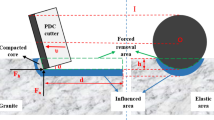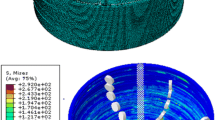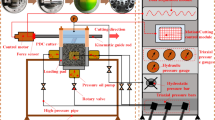Abstract
Rotary percussive drilling technology can solve the problems of low efficiency and high cost in deep hard formation drilling effectively; it can improve drilling efficiency and reduce stick-slip vibration in order to improve transmission efficiency of WOB (weight of bit). However, the rock breaking and ROP rising (rate of penetration) mechanism are not clear enough to some extent. This paper established three-dimensional finite element model of rotary percussive cutting by single PDC cutter. The crack propagation, chip formation, damage evolution, mechanical specific energy (MSE), and other problems are discussed. The results show that the hard rock is more prone to occur brittle failure under rotary percussive cutting, the rotary percussive drilling technology can improve the stress state of the PDC cutter, better to protect the cutter and improve the drilling efficiency; the magnitude of impact amplitude should not be too large when it reaches the threshold to break rock, the impact frequency has significant influence on MSE; rotary percussive drilling technology is not suitable for soft formations. The field applications show that the use of high-frequency impactor can bring obvious ROP rising in the hard formation drilling. The results obtained in this paper can enhance the understanding of rotary percussive drilling technology and provide theoretical basis for the design of impactor.
























Similar content being viewed by others
References
Chitty, D. E., Blouin, S. E., Zimmer, V. L., et al. (2005) “Rotary percussion sounding system for in situ rock mass characterization[C].” Alaska Rocks 2005, the 40th US Symposium on Rock Mechanics (USRMS). American Rock Mechanics Association
Gerlero, M., Soroldoni, T., and Barreto, D. (2014) “San Francisco Basin tight reservoir play: defining benefits of hammer bit/percussion drilling, onshore Brazil[C].” In IADC/SPE Drilling Conference and Exhibition. Society of Petroleum Engineers
Guarin, P. L., Arnold, H. E., Harpst, W. E., et al. (1949) “Rotary percussion drilling[C].” Drilling and Production Practice. American Petroleum Institute
Hoover ER, Middleton JN (1981) Laboratory evaluation of PDC drill bits under high-speed and high-wear conditions[J]. J Pet Technol 33(12):2316–2321
Han, G., Bruno, M., Lao, K. (2005a) “Percussion drilling in oil industry: review and rock failure modelling[C].” The AADE national technical conference and exhibition, pp 5–7
Han, G., Bruno, M., Dusseault, M. B. (2005b) “Dynamically modelling rock failure in percussion drilling[C].” The 40th US Symposium on Rock Mechanics (USRMS). American Rock Mechanics Association
Howard GC, Vincent RP, Wilder LB (1960) Development and field use of a high-frequency gas-operated rotary-percussion drilling tool[J]. J Pet Technol 12(05):20–26
Jiang HW, Liu YS, Zhai YH et al (2006) Research on rock crushing mechanics model in rotary and percussive drilling[J]. Petroleum Drilling Techniques 34(01):13–16
Karasawa H, Misawa S (1992) Laboratory testing to design PDC bits for geothermal well drilling[J]. Drilling Technol ASME 40:135–141
Kaitkay P, Lei S (2005) Experimental study of rock cutting under external hydrostatic pressure[J]. J Mater Process Technol 159(2):206–213
Li, X., Hood, M. and Xian, X. (1993) “Wear and damage to PDC bits[J].” SPE 2629
Lin YH, Shi TH, Liang Z et al (2004) Simulation of penetration rate of air percussion drilling bit[J]. Acta Pet Sin 25(05):88–92
Lin YH, Shi TH, Li RF et al (2005) Simulation of impact force and penetration rate of air hammer bit drilling[J]. Chin J Rock Mech Eng 24(18):3337–3341
Li GH, Bao HZ, Tao XH (2004) Effects of drilling conditions on crushing rocks while rotary percussion drilling[J]. Petroleum Drilling Techniques 32(02):4–7
Lei P, Ni HJ, Wang RH et al (2013) Field test of self-excited vibration rotary percussion drilling tool in deep and ultra-deep wells[J]. Petroleum Drilling Techniques 41(06):40–43
Melamed Y, Kiselev A, Gelfgat M et al (1996) Hydraulic hammer drilling technology: developments and capabilities[R]. Los Alamos National Lab, New Mexico
Markandeya, S., Merchant, D., Sha, D., et al. (2016) “Optimized PDC bit designs for percussion performance drilling system deliver higher penetration rates[C].” Offshore Technology Conference Asia
Ma GJ, Zhang HP, Wang JC (2016) Designed and testing of the positive displacement motor driven rotary percussion drilling device[J]. China Petroleum Machinery 44(06):24–27
Pennington, J. V. (1954) “Rock failure in percussion[J].” Pet Eng
Podio A, Gray KE (1965) Single-blow bit-tooth impact tests on saturated rocks under confining pressure: I. Zero pore pressure[J]. Soc Pet Eng J 5(03):211–224
Pletcher, J. P., Scarr, A., Smith, J., et al. (2010) “Application of air percussion drilling improves drilling efficiency in horizontal sandstone wells[C].” SPE Annual Technical Conference and Exhibition, Society of Petroleum Engineers
Powell, S. W., Herrington, D., Botton, B., et al. (2013) “Fluid hammer increases PDC performance through axial and torsional energy at the bit[C].” SPE Annual Technical Conference and Exhibition, Society of Petroleum Engineers
Powell, S. W., Ertai, H. (2015) “Hydraulic percussion drilling system with PDC bit increases ROP and lowers drilling cost[C].” SPE Middle East Unconventional Resources Conference and Exhibition, Society of Petroleum Engineers
Powell, S., Garcia, A., Barocio, H., et al. (2015) “Percussion drilling system combined with hybrid PDC bit increases ROP and interval drilled on Taoudenni basin well in Mauritania[C].” SPE/IADC Drilling Conference and Exhibition, Society of Petroleum Engineers
Rabia H (1985) A unified prediction model for percussive and rotary drilling[J]. Min Sci Technol 2(03):207–216
Simon R (1964) Transfer of the stress wave energy in the drill steel of a percussive drill to the rock[C]. Int J Rock Mech Mining Sci Geomech Abstr 1(03):397–411
Samuel, G. R. (1996) “Percussion Drilling... Is It a Lost Technique? A Review[C].” Permian Basin Oil and Gas Recovery Conference, Society of Petroleum Engineers
Sun LD, Zhou CN, Zhu RK et al (2013) Formation, distribution and potential of deep hydrocarbon resources in China[J]. Pet Explor Dev 40(06):687–695
Song C, Chung J, Kim JH et al (2017) Design optimization of a drifter using the Taguchi method for efficient percussion drilling[J]. J Mech Sci Technol 31(04):1797–1803
Teale R (1965) The concept of specific energy in rock drilling[J]. Int J Rock Mech Mining Sci Geomech Abstr 2(01):57–73
Tandanand, S. and Hartman, H. L. (1962) “Stress distribution beneath a wedge-shaped drill-bit loaded statically[M].” Mining Research, pp.799–831
Wanamaker JA (1951) Rotary percussion drilling in West Texas[J]. World Oil 133:182
Whiteley, M. C., England, W. P. (1985). “Air drilling operations improved by percussion bit/hammer tool tandem[C].” /SPE/IADC Drilling Conference, Society of Petroleum Engineers
Wells, E. J. (1949) “Penetration speed of percussion drill bits[J].” Chemical Engineering and Mining Review, pp. 362
Wiercigroch, M., Vaziri, V., Kapitaniak, M. (2017) “RED: revolutionary Drilling Technology for Hard Rock Formations[C].” SPE/IADC Drilling Conference and Exhibition, Society of Petroleum Engineers
Xuan, L., Guan, Z., Hu, H. (2015) Analysis and improvement of the rotary percussion drilling tool in oil wells[J]. Int Symp Mater Energy Environ Eng
Xuan, L., Guan, Z., Hu, H., et al. (2016) “The principle and application of a novel rotary percussion drilling tool drived by positive displacement motor[C].” IADC/SPE Asia Pacific Drilling Technology Conference, Society of Petroleum Engineers
Zhu XH, Luo H, Jia YJ (2012) Numerical analysis of air hammer bit drilling based on rock fatigue model[J]. Chin J Rock Mech Eng 31(04):754–761
Zhou, Y., Zhang, W., Gamwo, I.K., et al. (2012) “Mechanical specific energy versus depth of cut[C].” 46th US rock mechanics/Geomechanics symposium. American Rock Mechanics Association
Funding
This study is supported by the National Natural Science Foundation of China (Grant No. 51674214), International Cooperation Project of Sichuan Science and Technology Plan (2016HH0008), and Youth Science and Technology Innovation Research Team of Sichuan Province (2017TD0014). Such supports are greatly appreciated by the authors.
Author information
Authors and Affiliations
Corresponding author
Rights and permissions
About this article
Cite this article
Liu, W., Zhu, X. & Li, B. The rock breaking mechanism analysis of rotary percussive cutting by single PDC cutter. Arab J Geosci 11, 192 (2018). https://doi.org/10.1007/s12517-018-3530-6
Received:
Accepted:
Published:
DOI: https://doi.org/10.1007/s12517-018-3530-6




